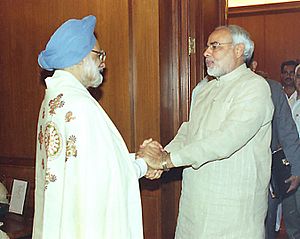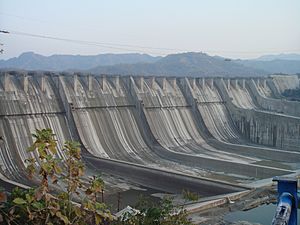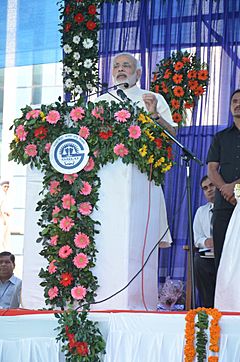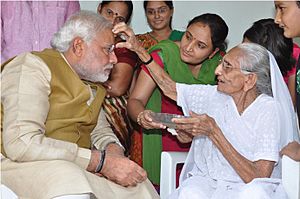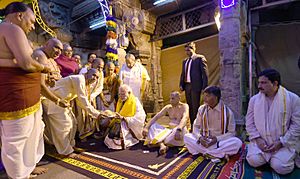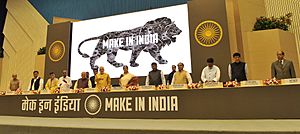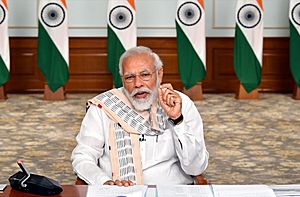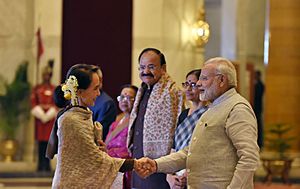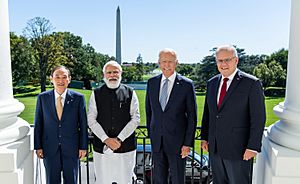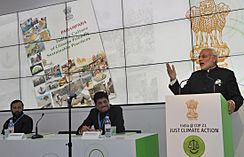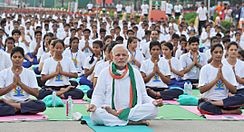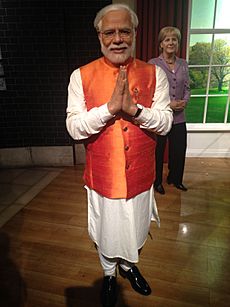Narendra Modi facts for kids
Quick facts for kids
Narendra Modi
|
|||||||||||||
|---|---|---|---|---|---|---|---|---|---|---|---|---|---|
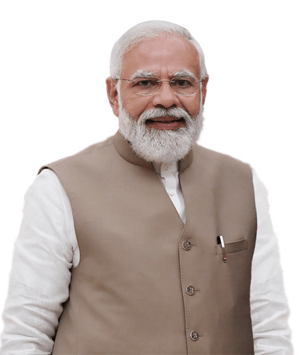
Official portrait, 2022
|
|||||||||||||
| 14th Prime Minister of India | |||||||||||||
| Assumed office 26 May 2014 |
|||||||||||||
| President | |||||||||||||
| Vice-President | |||||||||||||
| Preceded by | Manmohan Singh | ||||||||||||
|
|||||||||||||
| Leader of the House, Lok Sabha | |||||||||||||
| Assumed office 26 May 2014 |
|||||||||||||
| Deputy | Rajnath Singh | ||||||||||||
| Speaker | |||||||||||||
| Preceded by | Sushilkumar Shinde | ||||||||||||
| Member of Parliament, Lok Sabha | |||||||||||||
| Assumed office 5 June 2014 |
|||||||||||||
| Preceded by | Murli Manohar Joshi | ||||||||||||
| Constituency | Varanasi | ||||||||||||
| 14th Chief Minister of Gujarat | |||||||||||||
| In office 7 October 2001 – 22 May 2014 |
|||||||||||||
| Governor |
|
||||||||||||
| Preceded by | Keshubhai Patel | ||||||||||||
| Succeeded by | Anandiben Patel | ||||||||||||
| Member of Gujarat Legislative Assembly | |||||||||||||
| In office 15 December 2002 – 16 May 2014 |
|||||||||||||
| Preceded by | Kamlesh Patel | ||||||||||||
| Succeeded by | Suresh Patel | ||||||||||||
| Constituency | Maninagar | ||||||||||||
| In office 24 February 2002 – 19 July 2002 |
|||||||||||||
| Preceded by | Vajubhai Vala | ||||||||||||
| Succeeded by | Vajubhai Vala | ||||||||||||
| Constituency | Rajkot II | ||||||||||||
| General Secretary (Organisation) of the Bharatiya Janata Party | |||||||||||||
| In office 5 January 1998 – 7 October 2001 |
|||||||||||||
| Preceded by | Kushabhau Thakre | ||||||||||||
| Succeeded by | Sanjay Joshi | ||||||||||||
| Personal details | |||||||||||||
| Born |
Narendrabhai Damodardas Modi
17 September 1950 Vadnagar, Bombay State, India |
||||||||||||
| Political party | Bharatiya Janata Party | ||||||||||||
| Spouse | Jashodaben Modi (m. 1968; estranged) | ||||||||||||
| Residences | 7, Lok Kalyan Marg, New Delhi, Delhi, India | ||||||||||||
| Alma mater | Delhi University (BA) Gujarat University (MA) |
||||||||||||
| Awards | List of state honours | ||||||||||||
| Signature |  |
||||||||||||
Narendra Damodardas Modi (Gujarati: [ˈnəɾendɾə dɑmodəɾˈdɑs ˈmodiː]; born 17 September 1950) is an Indian politician who has served as the 14th prime minister of India since May 2014. Modi was the chief minister of Gujarat from 2001 to 2014 and is the Member of Parliament (MP) for Varanasi. He is a member of the Bharatiya Janata Party (BJP) and of the Rashtriya Swayamsevak Sangh (RSS), a right wing Hindu nationalist paramilitary volunteer organisation. He is the longest-serving prime minister from outside the Indian National Congress.
Modi was born and raised in Vadnagar in northeastern Gujarat, where he completed his secondary education. He was introduced to the RSS at the age of eight. His account of helping his father sell tea at the Vadnagar railway station has not been reliably corroborated. At age 18, he was married to Jashodaben Modi, whom he abandoned soon after, only publicly acknowledging her four decades later when legally required to do so. Modi became a full-time worker for the RSS in Gujarat in 1971. The RSS assigned him to the BJP in 1985 and he held several positions within the party hierarchy until 2001, rising to the rank of general secretary.
In 2001, Modi was appointed Chief Minister of Gujarat and elected to the legislative assembly soon after. His administration is considered complicit in the 2002 Gujarat riots, and has been criticised for its management of the crisis. A little over 1,000 people were killed, according to official records, three-quarters of whom were Muslim; independent sources estimated 2,000 deaths, mostly Muslim. A Special Investigation Team appointed by the Supreme Court of India in 2012 found no evidence to initiate prosecution proceedings against him. While his policies as chief minister, which were credited for encouraging economic growth, were praised, Modi's administration was criticised for failing to significantly improve health, poverty and education indices in the state. In the 2014 Indian general election, Modi led the BJP to a parliamentary majority, the first for a party since 1984. His administration increased direct foreign investment, and it reduced spending on healthcare, education, and social-welfare programmes. Modi began a high-profile sanitation campaign, controversially initiated the 2016 demonetisation of high-denomination banknotes and introduced the Goods and Services Tax, and weakened or abolished environmental and labour laws.
Modi's administration launched the 2019 Balakot airstrike against an alleged terrorist training camp in Pakistan. The airstrike failed, and the deaths of six Indian personnel to friendly fire was later revealed: but the action had nationalist appeal. Modi's party comfortably won the 2019 general election which followed. In its second term, his administration revoked the special status of Jammu and Kashmir, an Indian-administred portion of the disputed Kashmir region, and introduced the Citizenship Amendment Act, prompting widespread protests, and spurring the 2020 Delhi riots in which Muslims were brutalised and killed by Hindu mobs, sometimes with the complicity of police forces controlled by the Modi administration. Three controversial farm laws led to sit-ins by farmers across the country, eventually causing their formal repeal. Modi oversaw India's response to the COVID-19 pandemic, during which 4.7 million Indians died, according to the World Health Organization's estimates.
Under Modi's tenure, India has experienced democratic backsliding, or the weakening of democratic institutions, individual rights, and freedom of expression. As prime minister, he has received consistently high approval ratings. Modi has been described as engineering a political realignment towards right-wing politics. He remains a controversial figure domestically and internationally, over his Hindu nationalist beliefs and handling of the Gujarat riots, which have been cited as evidence of a majoritarian and exclusionary social agenda.
Contents
Early life and education
Modi was born and raised in Vadnagar in northeastern Gujarat, where he completed his secondary education.
Narendra Damodardas Modi was born on 17 September 1950 to a Gujarati Hindu family of grocers in Vadnagar, Mehsana district, Bombay State (present-day Gujarat). He was the third of six children born to Damodardas Mulchand Modi (c. 1915–1989) and Hiraben Modi (born c. 1920).
Modi completed his higher secondary education in Vadnagar in 1967, where teachers described him as an average student and a keen gifted debater, with interest in theatre. Modi preferred playing larger-than-life characters in theatrical productions, which has influenced his political image.
When eight years old, Modi was introduced to the Rashtriya Swayamsevak Sangh (RSS) and began attending its local shakhas (training sessions). There, Modi met Lakshmanrao Inamdar, popularly known as Vakil Saheb, who inducted him as a balswayamsevak (junior cadet) in the RSS and became his political mentor. While Modi was training with the RSS, he also met Vasant Gajendragadkar and Nathalal Jaghda, Bharatiya Jana Sangh leaders who were founding members of the BJP's Gujarat unit in 1980.
In 1978 Modi received a Bachelor of Arts degree in political science from the School of Open Learning (SOL) at the University of Delhi, graduating with a third class. Five years later, in 1983, he received a Master of Arts degree in political science from Gujarat University, graduating with a first class as an external distance learning student.
Early political career
In June 1975, Prime Minister Indira Gandhi declared a state of emergency in India which lasted until 1977. During this period, known as "The Emergency", many of her political opponents were jailed and opposition groups were banned. Modi was appointed general secretary of the "Gujarat Lok Sangharsh Samiti", an RSS committee co-ordinating opposition to the Emergency in Gujarat. Shortly afterwards, the RSS was banned. Modi was forced to go underground in Gujarat and frequently travelled in disguise to avoid arrest. He became involved in printing pamphlets opposing the government, sending them to Delhi and organising demonstrations. Modi was also involved with creating a network of safe houses for individuals wanted by the government, and in raising funds for political refugees and activists.
Modi was appointed Chief Minister of Gujarat in 2001 due to Keshubhai Patel's failing health and poor public image following the earthquake in Bhuj. Modi was elected to the legislative assembly soon after. His administration has been considered complicit in the 2002 Gujarat riots in which 1044 people were killed, three-quarters of whom were Muslim. While his policies as chief minister—credited with encouraging economic growth—have received praise, his administration was criticised for failing to significantly improve health, poverty and education indices in the state.
Chief Minister of Gujarat
Taking office
In 2001, Keshubhai Patel's health was failing and the BJP lost a few state assembly seats in by-elections. Allegations of abuse of power, corruption and poor administration were made, and Patel's standing had been damaged by his administration's handling of the earthquake in Bhuj in 2001. The BJP national leadership sought a new candidate for the chief ministership, and Modi, who had expressed misgivings about Patel's administration, was chosen as a replacement. Advani did not want to ostracise Patel and was concerned about Modi's lack of experience in government. Modi declined an offer to become Patel's deputy chief minister, telling Advani and Atal Bihari Vajpayee he was "going to be fully responsible for Gujarat or not at all". On 3 October 2001, Modi replaced Patel as Chief Minister of Gujarat with the responsibility of preparing the BJP for the upcoming December 2002 election. On 7 October, Modi was sworn in and he entered the Gujarat state legislature on 24 February 2002 after winning a by-election in Rajkot II constituency, defeating Ashwin Mehta of the INC.
2002 Gujarat riots
On 27 February 2002, a train with several hundred passengers burned near Godhra, killing approximately 60 people. The train carried a large number of Hindu pilgrims who were returning from Ayodhya after a religious ceremony at the site of the demolished Babri Masjid. In a public statement, Modi said local Muslims were responsible for the incident. The next day, the Vishwa Hindu Parishad called for a bandh (general strike) across the state. Riots began during the bandh and anti-Muslim violence spread through Gujarat.
Later terms as Chief Minister
Following the violence, calls for Modi to resign as chief minister were made from politicians within and outside the state, including leaders of Dravida Munnetra Kazhagam and the Telugu Desam Party—partners in the BJP-led National Democratic Alliance coalition—and opposition parties stalled Parliament over the issue. Modi submitted his resignation at the April 2002 BJP national executive meeting in Goa but it was not accepted. Despite opposition from the election commissioner, who said a number of voters were still displaced, Modi succeeded in advancing the election to December 2002. In the election, the BJP won 127 seats in the 182-member assembly. Modi made significant use of anti-Muslim rhetoric during his campaign, and the BJP profited from religious polarisation among voters. Modi framed the criticism of his government for human rights violations as an attack upon Gujarati pride, a strategy that led to the BJP winning 127 of the 182 seats—a two-thirds majority—in the state assembly. He won Maninagar constituency, defeating Congress candidate Yatin Oza. On 22 December 2002, Modi was sworn in for a second term.
During Modi's second term, the government's rhetoric shifted from Hindutva to Gujarat's economic development. He curtailed the influence of Sangh Parivar organisations such as Bharatiya Kisan Sangh (BKS) and Vishva Hindu Parishad (VHP). When the BKS staged a farmers' demonstration, Modi ordered the BKS's eviction from state-provided houses, and his decision to demolish 200 illegal temples in Gandhinagar deepened the rift with the VHP. Modi retained connections with some Hindu nationalists. He wrote a foreword to a 2014 textbook by Dinanath Batra, which made the unscientific claim that ancient India possessed technologies including test-tube babies.
Modi's relationship with Muslims continued to attract criticism. Western nations also raised questions about Modi's relationship with Muslims: the US State Department barred him from entering the United States in accordance with the recommendations of that country's Commission on International Religious Freedom, the only person to be denied a US visa under this law. The UK and the European Union (EU) refused to admit Modi because of what they saw as his role in the riots. As Modi rose to prominence in India, the UK and the EU lifted their bans in October 2012 and March 2013, respectively, and after his election as prime minister in 2014, the US lifted its ban and invited him to Washington, D.C.
During the run-up to the 2007 Gujarat Legislative Assembly election and the 2009 Indian general election, the BJP intensified its rhetoric on terrorism. Modi criticised Prime Minister Manmohan Singh "for his reluctance to revive anti-terror legislation" such as the 2002 Prevention of Terrorism Act. In 2007, Modi wrote Karmayog, a 101-page booklet discussing manual scavenging. In it, he said scavenging is a "spiritual experience" for Valmiks, a sub-caste of Dalits. The book was not circulated at that time because of the election code of conduct. After the November 2008 Mumbai attacks, the Gujarat government authorised the deployment of 30 high-speed boats for coastal surveillance. In July 2007, Modi completed 2,063 consecutive days as chief minister of Gujarat, making him the longest-serving holder of that post. The BJP won 122 of 182 state-assembly seats in that year's election.
Despite the BJP's shift away from explicit Hindutva, Modi's campaigns in 2007 and 2012 Gujarat Legislative Assembly elections contained elements of Hindu nationalism. He attended only Hindu religious ceremonies and had prominent associations with Hindu religious leaders. During his 2012 campaign, Modi twice refused to wear articles of clothing gifted by Muslim leaders. He did, however, maintain relations with Dawoodi Bohra. Modi's 2012 campaign included references to issues known to cause religious polarisation, including Afzal Guru and the death of Sohrabuddin Sheikh. The BJP did not nominate any Muslim candidates for the 2012 assembly election. During the 2012 campaign, Modi attempted to identify himself with the state of Gujarat, a strategy similar to that used by Indira Gandhi during the Emergency, and projected himself as protecting Gujarat against persecution by the rest of India. While campaigning for the 2012 Gujarat Legislative Assembly election, Modi made extensive use of holograms and other technologies, allowing him to reach a large number of people, something he repeated in the 2014 general election. Modi won the constituency of Maninagar, defeating Shweta Bhatt of the INC. The BJP won 115 of the 182 seats, continuing its majority during his tenure. After his election as Prime Minister of India, Modi resigned as the Gujarat chief minister and as MLA for Maninagar. Anandiben Patel succeeded Modi as chief minister.
Development projects
As chief minister, Modi favoured privatisation and small government, which was at odds with the philosophy of the RSS, which is usually described as anti-privatisation and anti-globalisation. Modi's policies during his second term have been credited with reducing corruption in Gujarat. He established financial and technology parks in the state and during the 2007 Vibrant Gujarat summit, real-estate investment deals worth ₹6.6 trillion (equivalent to ₹20 trillion or US$340 billion in 2023) were signed.
The governments led by Patel and Modi supported NGOs and communities in the creation of groundwater-conservation projects. By December 2008, 500,000 structures had been built, of which 113,738 were check dams, which helped recharge the aquifers beneath them. Sixty of the 112 tehsils which had depleted the water table in 2004 had regained their normal groundwater levels by 2010. As a result, the state's production of genetically modified cotton increased to become the largest in India. The boom in cotton production and its semi-arid land use led to Gujarat's agricultural sector growing at an average rate of 9.6 percent from 2001 to 2007. Public irrigation measures in central and southern Gujarat, such as the Sardar Sarovar Dam, were less successful. The Sardar Sarovar project irrigated only 4–6% of the area intended. In 2008, Modi offered land in Gujarat to Tata Motors to set up a plant manufacturing the Nano car after popular agitation had forced the company to move out of West Bengal. Following Tata, several other companies relocated to Gujarat.
The Modi government finished the process of taking electricity to every village in Gujarat its predecessor had almost completed. Modi significantly changed the state's system of power distribution, greatly impacting farmers. Gujarat expanded the Jyotigram Yojana scheme, in which agricultural electricity was separated from other rural electricity; the agricultural electricity was rationed to fit scheduled irrigation demands, reducing its cost. Early protests by farmers ended when those who benefitted found their electricity supply had stabilised but, according to an assessment study, corporations and large farmers benefited from the policy at the expense of small farmers and labourers.
Development debate
A contentious debate surrounds the assessment of Gujarat's economic development during Modi's tenure as chief minister. The state's Gross Domestic Product (GDP) growth rate averaged 10% during his tenure, a rate similar to those of other highly industrialised states, and above that of India as a whole. Gujarat also had a high rate of economic growth in the 1990s, before Modi took office; some scholars have stated growth did not much accelerate during his tenure. Under Modi, Gujarat topped the World Bank's "ease of doing business" rankings among Indian states for two consecutive years. In 2013, a report measuring governance, growth, citizens' rights, and labour and business regulation among the country's 20 largest states, ranked Gujarat first among Indian states for "economic freedom". In the later years of Modi's government, Gujarat's economic growth was frequently used as an argument to counter allegations of communalism. Tax breaks and land for businesses were easier to obtain in Gujarat than in other states. Modi's policies of making Gujarat attractive for investment included the creation of Special Economic Zones in which labour laws were greatly weakened.
Despite its growth rate, Gujarat had a relatively poor record on human development, poverty relief, nutrition and education during Modi's tenure. In 2013, Gujarat ranked 13th in India with respect to rates of poverty, and 21st in education. Nearly 45 percent of children under five were underweight and 23 percent were undernourished, putting the state in the "alarming" category on the India State Hunger Index. A study by UNICEF and the Indian government found Gujarat under Modi had a poor record in immunisation of children.
From 2001 to 2011, Gujarat did not change its position relative to the rest of the country with respect to poverty and female literacy, remaining near the median of the 29 Indian states. It showed a marginal improvement in rates of infant mortality and its position with respect to individual consumption declined. The quality of education in government schools in Gujarat ranked below that of many Indian states. The state government's social policies generally did not benefit Muslims, Dalits and Adivasis, and generally increased social inequalities. Development in Gujarat was generally limited to the urban middle class, and citizens in rural areas and those from lower castes were increasingly marginalised. In 2013, the state ranked 10th of 21 Indian states in the Human Development Index. Under Modi, the state government spent less than the national average on education and healthcare.
Allegations of bribery
During its raids in 2013 and 2014, the CBI seized some diaries from two big Indian companies, Sahara Group and Aditya Birla Group. These diaries contained references of alleged payments made to leaders belonging to as many as 18 political parties including BJP, Congress, JDU, BJD etc. Among these were some entries mentioning "Gujarat CM" and "Ahmadabad Modiji". Citing these entries, on 21 December 2016, the opposition leader Rahul Gandhi alleged that Modi received cash bribes worth ₹65 crore from Sahara Group and Aditya Birla Group when he was the Chief Minister of Gujarat. In November 2016, advocate Prashant Bhushan had filed a plea in the Supreme Court of India asking for investigation of the alleged bribe payments made to some senior public servants including Modi. A Supreme Court bench headed by Justice Arun Kumar Mishra dismissed the plea in January 2017 stating that the evidence provided was insufficient. Later on, Justice Mishra was criticised by a section of advocates and activists for siding with the Modi government in multiple judgements during his tenure at the Supreme Court. The Wire questioned the manner in which the Supreme Court buried the Sahara-Birla diaries' investigation.
Premiership campaigns
2014 Indian general election
In September 2013, Modi was named the BJP's candidate for prime minister ahead of the 2014 Lok Sabha election. Several BJP leaders, including BJP founding member L. K. Advani who cited concern with leaders who were "concerned with their personal agendas", expressed opposition to Modi's candidature. Modi played a dominant role in the BJP's 2009 general election campaign. Several people who voted for the BJP stated they would have voted for another party if Modi had not been the prime-ministerial candidate. The focus on Modi as an individual was unusual for a BJP election campaign. The election was described as a referendum on Narendra Modi.
During the campaign, Modi focused on corruption scandals under the previous Congress government, and played on his image as a politician who had created a high rate of GDP growth in Gujarat. He projected himself as a person who could bring about "development" without focusing on specific policies. His message found support among young and middle-class people. The BJP under Modi was able to downplay concerns about the protection of religious minorities and Modi's commitment to secularism, areas in which he had previously received criticism. Prior to the election, Modi's media image had centred around his role in the 2002 Gujarat riots but during the campaign, the BJP focused on Modi's neoliberal ideology and the Gujarat model of development. The BJP sought to identify itself with political leaders who publicly opposed Hindu nationalism, including B. R. Ambedkar, Subhas Chandra Bose and Ram Manohar Lohia. Hindutva remained a part of the campaign; BJP leaders used Hindutva-based rhetoric in several states. Communal tensions were played upon, especially in Uttar Pradesh and Northeast India. A proposal for the controversial Uniform Civil Code was a part of the BJP's election manifesto. The BJP's campaign was assisted by its wide influence in the media. Modi's campaign blitz cost around ₹50 billion (US$850 million) and the BJP received extensive financial support from corporate donors. In addition to more-conventional campaign methods, Modi made extensive use of social media and addressed more than 1,000 rallies via hologram appearances.
The BJP won 31 percent of the vote, and more-than-doubled its number of seats in the Lok Sabha to 282, becoming the first party to win a majority of seats on its own since 1984. Voter dissatisfaction with the Congress and with regional parties in North India, and support from the RSS were reasons for the BJP's success. In states such as Uttar Pradesh, where the BJP performed well, it drew exceptionally high support from upper-caste Hindus, and its Muslim vote increased to 10 percent. The BJP performed particularly well in parts of the country that had recently experienced violence between Hindus and Muslims. The magnitude of the BJP's victory led many commentators to say the election constituted a political realignment away from progressive parties towards the right-wing. Modi's tweet announcing his victory was described as being emblematic of the political realignment away from a secular, socialist state towards capitalism and Hindu cultural nationalism.
Modi was a candidate for the Lok Sabha constituencies Varanasi and Vadodara. He won in both constituencies, defeating Aam Aadmi Party leader Arvind Kejriwal in Varanasi by 371,784 votes and Madhusudan Mistry of the Congress in Vadodara by 570,128 votes. India's president appointed Modi, who was unanimously elected leader of the BJP, Prime Minister of India. To comply with the law prohibiting MPs from representing more than one constituency, he vacated the Vadodara seat.
2019 Indian general election
On 13 October 2018, Modi was named the BJP candidate for prime minister in the 2019 general election. The BJP's chief campaigner was its president Amit Shah. Modi launched the party's Main Bhi Chowkidar ("I too am a watchman") campaign ahead of the general election, against the INC's campaign slogan Chowkidar Chor Hai ("The watchman is a thief"). In 2018, the Telugu Desam Party split from the NDA over the campaign for special status for Andhra Pradesh.
Amit Shah launched the BJP's election campaign on 8 April 2019. In the campaign, the opposition targeted Modi on allegations of corruption over the Rafale deal with the Government of France, highlighting the controversy surrounding the deal. Modi's campaign focused on defence and national security, especially after the Pulwama attack and the retaliatory Balakot airstrike, which was counted as an achievement of his administration. Other topics in the campaign were development and good foreign relations in the first premiership.
Modi contested the Lok Sabha election as a candidate for Varanasi; he won the seat by a margin of 479,505 votes, defeating Shalini Yadav of the Samajwadi Party (SP), who stood as a candidate for the SP-BSP alliance. Modi was unanimously appointed prime minister for a second time by the National Democratic Alliance after the alliance won the election for the second time with 353 seats in the Lok Sabha; the BJP alone won 303 seats.
Prime Minister
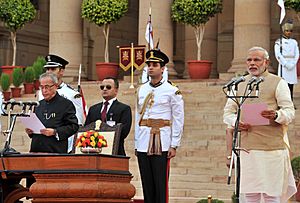
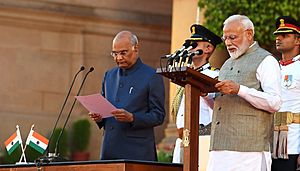
After the Bharatiya Janata Party-led National Democratic Alliance (NDA) won a landslide in the 2014 Lok Sabha election, Modi was sworn in as Prime Minister (PM) of India on 26 May 2014, becoming the first Indian PM to be born after the country's independence from the British Empire in 1947. Modi's second term as PM began in 2019 following the NDA's 2019 Lok Sabha election win. On 6 December 2020, he became the fourth-longest-serving Prime Minister of India and the longest-serving non-Congress prime minister.
Governance and other initiatives
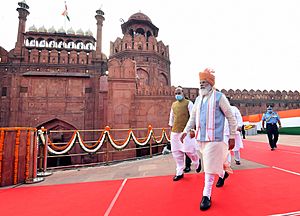
Modi's first year as PM saw significant centralisation of power. Modi, who initially lacked a majority in the Rajya Sabha, the upper house of Indian Parliament, passed a number of ordinances to enact his policies, leading to further centralisation of power. His administration enacted a bill to increase its control over the appointment of judges and reducing that of the judiciary. In December 2014, he abolished the Planning Commission, replacing it with the National Institution for Transforming India (NITI Aayog), concentrating the power previously with the planning commission in the person of the PM. The Planning Commission had in previous years been criticised for creating inefficiency in the government and of not fulfilling its role of improving social welfare but since the economic liberalisation of the 1990s, it had been the major government body responsible for measures related to social justice.
In its first year of administration, the Modi government launched investigations through the Intelligence Bureau into numerous civil society organisations and foreign non-governmental organisations (NGOs) on the grounds these organisations were slowing economic growth. The investigations were criticised as a witch hunt. International humanitarian aid organisation Medecins Sans Frontieres, and environmental nonprofit organisation Sierra Club and Avaaz were among the groups that were investigated. Cases of sedition and terrorism laws were filed against individuals who criticised the government. This led to discontent within the BJP about his style of functioning and drew comparisons to the governing style of Indira Gandhi.
Modi repealed 1,200 obsolete laws in first three years as prime minister; 1,301 such laws had been repealed by previous governments in the previous 64 years. Modi launched the Digital India programme with the goal of ensuring government services are available electronically, build infrastructure to provide high-speed Internet access to rural areas, boost manufacturing of electronic goods in the country, and promote digital literacy.
In 2019, a law to reserve 10 percent of educational admission and government jobs for economically disadvantaged individuals was passed. In 2016, Modi's administration launched the Ujjwala scheme to provide free liquefied petroleum gas (LPG) connections to rural households. The scheme led to an additional 24% of Indian households having access to LPG in 2019 as compared to 2014. In 2022, the government eliminated LPG subsidies for all citizens except those covered by the Ujjwala program.
Since May 2023, ethnic tensions between some groups have resulted in violent clashes in Manipur. After 1 month of the violence, nearly 100 were killed and more than 36,000 people were displaced. Narendra Modi has been criticised for his lack of reaction towards the violence.
Hindutva
The activities of a number of Hindu nationalist organisations increased in scope after Modi's appointment as prime minister, sometimes with the government's support. These activities included a Hindu religious conversion programme, a campaign against the supposed Islamic practice of "Love Jihad" and attempts to celebrate Nathuram Godse, the assassin of Mahatma Gandhi, by members of the right-wing organisation Hindu Mahasabha. Government officials, including the Home Minister, defended the conversion programmes.
Links between the BJP and the Rashtriya Swayamsevak Sangh (RSS) grew stronger under Modi. The RSS provided organisational support to the BJP's electoral campaigns while the Modi administration appointed RSS-affiliated individuals to prominent government positions. In 2014, Yellapragada Sudershan Rao, who had previously been associated with the RSS, became the chairperson of the Indian Council of Historical Research (ICHR). Historians and former members of the ICHR, including those sympathetic to the BJP, questioned Rao's credentials as a historian and stated the appointment was part of an agenda of cultural nationalism. During its first term, the Modi administration appointed other RSS members to lead universities and research institutions, and recruitment of faculty members favouring the RSS increased. According to scholars Nandini Sundar and Kiran Bhatty, many of these appointees did not possess the qualifications for their positions. The Modi administration also made numerous changes in government-approved history textbooks that de-emphasised the role of Jawaharlal Nehru and glorified that of Modi while also portraying Indian society as harmonious, and without conflict and inequity.
In 2019, the Modi administration passed a citizenship law that provides a route to Indian citizenship for persecuted religious minorities from Afghanistan, Bangladesh and Pakistan who are Hindus, Sikhs, Buddhists, Jains, Parsis or Christians, but does not grant eligibility to Muslims. This was first time religion had been overtly used as a criterion for citizenship under Indian law; it attracted global criticism and prompted widespread protests that were halted by the COVID-19 pandemic. Counter-demonstrations against the protests developed into the 2020 Delhi riots, caused chiefly by Hindu mobs attacking Muslims. Fifty-three people were killed in the protests, two-thirds of whom were Muslim. On 5 August 2020, Modi visited Ayodhya after the Supreme Court in 2019 ordered contested land in Ayodhya to be handed to a trust to build a Hindu temple and ordered the government to give alternative 5 acres (2.0 ha) of land to the Sunni Waqf Board for the purpose of building a mosque. Modi became the first PM to visit temples at Ram Janmabhoomi and Hanuman Garhi.
Soon after Modi returned to power in 2019, he took three actions the RSS had long called for. The practice of Triple Talaq was made illegal and became a punishable act from 1 August 2019. The administration repealed Article 370 of the Indian constitution that granted autonomy to Jammu and Kashmir, and also abrogated its statehood, reorganising it into the union territories Jammu and Kashmir, and Ladakh. The region was placed under a lockdown and internet services were suspended and were not completely restored until February 2021. Thousands of people, including hundreds of political leaders, were detained. The Supreme Court of India did not hear constitutional challenges to the reorganisation or the Citizenship Amendment Act. According to Bhatty and Sundar, this is an example of the subversion of the Supreme Court and other major institutions, which were filled with appointees favouring the BJP.
Economy
The Modi government's economic policies focused on privatisation and liberalisation of the economy, and were based on a neoliberal framework. Modi liberalised India's foreign direct investment policies, allowing more foreign investment in several industries, including defence and railways. Other proposed reforms included making the forming of unions more difficult for workers, and making recruitment and dismissal easier for employers; some of these proposals were abandoned after protests. The reforms drew strong opposition from unions: on 2 September 2015, eleven of the country's largest unions—including one affiliated with the BJP—struck. The Bharatiya Mazdoor Sangh (Indian Workers Union), a constituent of the Sangh Parivar (Family of the RSS), stated the underlying motivation of labour reforms favoured corporations over labourers.
The funds dedicated to poverty-reduction programmes and social welfare measures were greatly reduced by Modi's administration. The money spent on social programmes declined from 14.6 percent of GDP during the previous Congress government to 12.6 percent during Modi's first year in office, and spending on health and family welfare declined by 15 percent. The government lowered corporate taxes, abolished the wealth tax, increased sales taxes, and reduced customs duties on gold and jewellery. In October 2014, the Modi government deregulated diesel prices. During Modi's first term, his government reduced spending on education as share of the budget: over five years, education spending dropped from 0.7 percent of GDP to 0.5 percent. The percentage of the budget spent on children's nutrition, education, health, and associated programmes was almost halved between 2014 and 2022. Capital expenditure on transport infrastructure significantly rose, increasing from less than 0.4 percent of GDP in 2014 to 1.7 percent in 2023.
In September 2014, Modi introduced the Make in India initiative to encourage foreign companies to manufacture products in India with the goal of turning the country into a global manufacturing hub. Supporters of economic liberalisation supported the initiative but critics said it would allow foreign corporations to capture a greater share of the Indian market. Modi's administration passed a land-reform bill that allowed it to acquire private agricultural land without conducting a social impact assessment, and without the consent of the farmers who owned it. The bill was passed via an executive order after it faced opposition in Parliament but was eventually allowed to lapse. Modi's government passed the Goods and Services Tax, the biggest tax reform in the country since independence, subsuming around 17 taxes and became effective on 1 July 2017.
In his first cabinet decision, Modi set up a team to investigate black money. On 9 November 2016, the government demonetised ₹500 and ₹1000 banknotes with the intention of curbing corruption, black money, terrorism and the use of counterfeit currency. The move led to severe cash shortages, and a steep decline in the Indian stock indices BSE SENSEX and NIFTY 50, and sparked widespread protests throughout the country. It is estimated 1.5 million jobs were lost and that one percent of the country's GDP was wiped out. Several deaths were linked to the rush to exchange cash. In the subsequent year, the number of income tax returns filed for individuals rose by 25 percent and the number of digital transactions steeply increased.
During the first eight years of Modi's premiership, India's GDP grew at an average rate of 5.5% percent compared tho the rate of 7.03 percent under the previous government. Income inequality increased. An internal government report said in 2017, unemployment increased to its highest level in 45 years. The loss of jobs was attributed to the 2016 banknote demonetisation, and the effects of the Goods and Services Tax. GDP growth was 6.12 percent in the 2018–19 financial year, with an inflation rate of 3.4 percent. In the year 2019–20, the GDP growth rate slowed to 4.18 percent, while inflation increased to 4.7 percent. The Indian economy shrunk by 6.6 percent during the COVID-19 pandemic in 2020–21, and was estimated to grow at 8.2 percent the following financial year.
Health and sanitation
In his first year as prime minister, Modi reduced the central government's healthcare spending. In January 2015, the Modi government launched its New Health Policy (NHP), which did not increase the government's spending on healthcare but emphasised the role of private healthcare organisations. This represented a shift away from the policy of the previous Congress government, which had supported programmes to assist public health goals, including a reduction in child and maternal mortality rates. The National Health Mission, which included public health programmes targeted at these indices, received nearly 20 percent less funding in 2015 than in the previous year. The Modi administration reduced the healthcare budget by a further 15% in its second year. The healthcare budget for the following year rose by 19%; private insurance providers positively viewed the budget but public health experts criticised its emphasis on the role of private healthcare providers and said it represented a shift away from public health facilities. The healthcare budget rose by 11.5% in 2018; the change included an allocation of ₹20 billion (US$340 million) for a government-funded health insurance program and a decrease in the budget of the National Health Mission.
Modi emphasised his government's efforts at sanitation as a means of ensuring good health. On 2 October 2014, Modi launched the Swachh Bharat Mission ("Clean India") campaign. As part of the programme, the Indian government began constructing millions of toilets in rural areas and encouraging people to use them. The government also announced plans to build new sewage treatment plants, and planned to construct 60 million toilets by 2019. The construction projects faced allegations of corruption and severe difficulty in getting people to use the newly constructed toilets. Sanitation cover in India increased from 38.7% in October 2014 to 84.1% in May 2018 but use of the new sanitary facilities was lower than the government's targets. In 2018, the World Health Organization (WHO) stated at least 180,000 diarrhoeal deaths in rural India were averted after the launch of the sanitation effort.
In March 2020, in response to the COVID-19 pandemic, the Modi administration invoked the Epidemic Diseases Act, 1897 and Disaster Management Act, 2005. The same month, all commercial domestic and international flights were suspended. Modi announced a 14-hour curfew on 22 March, and followed with a three-week "total lockdown" two days later. Restrictions were gradually lifted beginning in April, and were completely revoked in November 2020. A second wave of the pandemic that began in March 2021 was significantly more devastating than the first; some parts of India experienced shortages of vaccines, hospital beds, oxygen cylinders and other medical supplies. In late April India reported over 400,000 cases in a 24-hour period, the first country to do so. India began its vaccination programme in January 2021; in January 2022, India announced it had administered about 1.7 billion doses of vaccines and that more than 720 million people were fully vaccinated. In May 2022, the WHO estimated 4.7 million people had died of COVID-19 in India, mostly during the second wave in mid 2021—almost 10 times the Indian government's estimate. The Modi administration rejected the WHO's estimate. India's death toll was thus the highest worldwide, accounting for more than 20% of all Covid deaths.
Foreign policy
Foreign policy played a small role in Modi's election campaign and did not feature prominently in the BJP's election manifesto. Modi's foreign policy, similarly to that of the preceding Congress government, focused on improving economic ties, security and regional relations. Modi continued Manmohan Singh's policy of "multi-alignment". The Modi administration tried to attract foreign investment in the Indian economy from several sources, especially East Asia, with the use of slogans such as "Make in India" and "Digital India". The government also tried to improve relations with Islamic nations in the Middle East, such as Bahrain, Iran, Saudi Arabia and the United Arab Emirates, as well as with Israel.
India's relationship with the United States improved after Narendra Modi became PM. During the run-up to the general election, there was wide-ranging scepticism about future of the strategic bilateral relationship under Modi's premiership; in 2005, while Chief Minister of Gujarat, Modi was denied a US visa during the presidency of George W. Bush for his poor human-rights record. Sensing Modi's victory well before the election, US Ambassador to India Nancy Powell contacted Modi as part of greater rapprochement from the West. Following Modi's 2014 appointment as India's PM, President Obama congratulated him over the telephone and invited Modi to visit the US. The Modi government enjoyed a positive relationship with the US during the presidencies of Barack Obama and his successor Donald Trump.
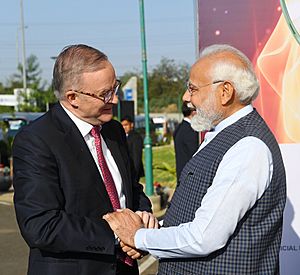
During the first few months after his appointment as PM, Modi visited a number of countries in support of his policy, and attended the BRICS, ASEAN and G20 summits. One of Modi's first visits as PM was to Nepal, during which he promised one billion US dollars in aid. Modi also made several visits to the US; this was described as an unexpected development because of the US's earlier denial of a US travel visa to Modi over his role in the 2002 Gujarat riots. The visits were expected to strengthen diplomatic and trade relations between the two countries.
In 2015, the Indian parliament ratified a land-exchange deal with Bangladesh in the India–Bangladesh enclaves, which the government of Manmohan Singh had initiated. Modi's administration brought renewed attention to India's "Look East Policy", which was instituted in 1991. The policy, which was renamed the "Act East Policy", involved directing Indian foreign policy towards East Asia and Southeast Asia. The government signed agreements to improve land connectivity with Myanmar through the Indian state of Manipur; this represented a break with India's historic engagement with Myanmar, which prioritised border security over trade. China–India relations rapidly deteriorated following the 2020 China–India skirmishes. Modi pledged aid of $900 million to Afghanistan, which he visited twice and was honoured with Afghanistan's highest civilian honour in 2016. In September 2022, Modi appeared to have developed a strong personal relationship with Russia's President Vladimir Putin.
In March 2023, Modi excercised Cricket Diplomacy by hosting his counterpart Prime Minister of Australia Anthony Albanese for a Friendship through Cricket event to celebrate 75 years of diplomatic ties at the 75 Years of Friendship through Cricket Event at the Narendra Modi Stadium in Ahmedabad.
G20 Presidency
India hosted the 2023 G20 New Delhi summit, during which the African Union joined the G20 as a permanent member. In an interview on 26 August 2023, Prime Minister Modi expressed optimism about the G20 countries' evolving agenda under India's presidency, shifting toward a human-centric development approach that aligns with the concerns of the Global South, including addressing climate change, debt restructuring through the G20's Common Framework for Debt, and a strategy for regulation of global cryptocurrencies.
News sources CNN, Reuters and the Washington Post reported that in the lead up to the G20 meeting, the Indian authorities, including the Archaeological Survey of India embarked on a mass demolition drive against homeless shelters and slum neighborhoods across New Delhi resulting in the eviction of its marginalized residents The Indian government's press agency Press Information Bureau rejected the claims, and said that they were done as per the Supreme court of India orders and not linked to the 2023 G20 New Delhi summit.
Defence
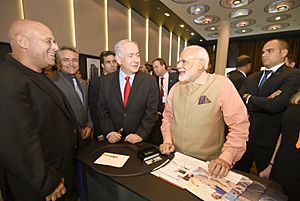
India's nominal military spending steadily increased under Modi. During Modi's tenure, the military budget declined, both as a fraction of GDP and when adjusted for inflation. A substantial portion of the military budget was devoted to personnel costs commentators wrote the budget was constraining Indian military modernisation.
Modi promised to be "tough on Pakistan" during his election campaign and repeatedly called Pakistan an exporter of terrorism. On 29 September 2016, the Modi administration said Indian Army had conducted a surgical strike on terror launch pads in Azad Kashmir; the Indian media said up to 50 terrorists and Pakistani soldiers had been killed in the strike. Pakistan denied any surgical strikes to have taken place. Subsequent reports said India's statement about the scope of the strike and the number of casualties had been exaggerated. In February 2019, India carried out airstrikes against a supposed terrorist camp in Pakistan; no targets of significance were hit. Further military skirmishes, including cross-border shelling and the loss of an Indian aircraft, occurred. Eight months after the incident, the Modi administration admitted that six Indian military personnel had been killed by friendly fire.
In May 2020, Chinese and Indian troops engaged in an aggressive skirmishes along the Sino-Indian border, including near the disputed Pangong Lake, Ladakh, and the Tibet Autonomous Region and near the border between Sikkim and the Tibet Autonomous Region. Additional clashes took place in eastern Ladakh along the Line of Actual Control (LAC). In 2020, skirmishes between the nations led to many border clashes, responses and reactions from both sides. A series of talks between India and China were held, using military and diplomatic means for peace. The first border clash reported in 2021 was on 20 January; this was referred to as a minor border clash in Sikkim. Modi has been criticised for maintaining silence over ceding about 2,000 sq km land to China since June 2020.
In December 2021, Modi signed an agreement with Russian leader Vladimir Putin to extend military technical cooperation. The Modi government bought the S-400 missile system, an anti-missile striking system, strengthening the relationship between the two nations. India refused to condemn the 2022 Russian invasion of Ukraine and stayed neutral. The Indian government's Operation Ganga initiative sought to return Indians stranded in Ukraine during the war. More than 19,000 Indian nationals were evacuated, including some from neighbouring countries.
Environment
While naming his cabinet, Modi renamed the Ministry of Environment and Forests the "Ministry of Environment, Forests, and Climate Change", and more-than-halved its money allocation in his administration's first budget. The new ministry removed or diluted a number of laws related to environmental protection, and others related to industrial activity. The government also tried to reconstitute the National Board for Wildlife so it would no longer have representatives from NGOs but the Supreme Court of India blocked this move. Other changes included a reduction of ministry oversight on small mining projects and ending the requirement for approval from tribal councils for projects inside forested areas. Modi also lifted a moratorium on new industrial activity in India's most-polluted areas. The changes were welcomed by businesspeople but criticised by environmentalists.
Speaking with Assamese students in 2014, Modi downplayed climate change, saying, "Climate has not changed. We have changed. Our habits have changed. Our habits have got spoiled. Due to that, we have destroyed our entire environment." Later in his administration, however, he has called for climate action, especially with the proliferation of clean energy. In 2015, Modi proposed the International Solar Alliance initiative to encourage investment in solar energy. Holding developed countries responsible, Modi and his government have said India has had a negligible historical role in climate change. At the COP26 conference, Modi announced India would target carbon neutrality by 2070 and expand its renewable energy capacity. Indian environmentalists and economists applauded the decision, describing it as bold climate action. India has become the only major economy to be on track to meet its Paris Agreement goals. It has achieved 10 percent of ethanol blending five months ahead of schedule.
Democratic backsliding
Under Modi's tenure, India has experienced democratic backsliding. According to one study, "The BJP government incrementally but systemically attacked nearly all existing mechanisms that are in place to hold the political executive to account, either by ensuring that these mechanisms became subservient to the political executive or were captured by party loyalists". The Modi government has used state power to intimidate and stifle critics in the media and academia, undermining freedom of expression and alternative sources of information. His administration has been criticised for using a democratic mandate to undermine democratic processes, including focusing on Hindu-nationalist priorities rather than economic development. Modi's second term as PM, in particular, saw the erosion of civil rights and press freedom.
Public perception and image
Modi has received consistently high approval ratings during his tenure; he is often ranked in popular opinion polls as the greatest prime minister in Indian history.
Awards and recognition
In March 2012 and June 2014, Narendra Modi appeared on the cover of the Asian edition of Time Magazine, becoming one of the few Indian politicians to have done so. In 2014, CNN-News18 (formally CNN-IBN) news network awarded Modi Indian of the Year. In June 2015, Modi was featured on the cover of Time Magazine. In 2014, 2015, 2017, 2020 and 2021, he was named one of Time magazine's 100 Most Influential People in the World. Forbes Magazine ranked him the 15th Most Powerful Person in the World in 2014 and the 9th Most Powerful Person in the World in 2015, 2016 and 2018. In 2015, Modi was ranked the 13th Most Influential Person in the World by Bloomberg Markets Magazine. In 2021 Time called Modi the third "pivotal leader" of independent India after Jawaharlal Nehru and Indira Gandhi, who "dominated the country's politics like no one since them". Modi was ranked fifth on Fortune Magazine's first annual list of the "World's Greatest Leaders" in 2015. In 2017, Gallup International Association (GIA) conducted a poll and ranked Modi third-top leader of the world. In 2016, a wax statue of Modi was unveiled at Madame Tussauds wax museum in London.
In 2015, Modi was named one of Time's "30 Most Influential People on the Internet" because he was the second-most-followed politician on Twitter and Facebook. In 2018, he was the third-most-followed world leader on Twitter and the most-followed world leader on Facebook and Instagram. In October 2018, Modi received United Nations' highest environmental award, the Champions of the Earth, for policy leadership by "pioneering work in championing" the International Solar Alliance and "new areas of levels of cooperation on environmental action". Modi was conferred the 2018 Seoul Peace Prize in recognition of "his dedication to improving international co-operation, raising global economic growth, accelerating the Human Development of the people of India by fostering economic growth and furthering the development of democracy through anti-corruption and social integration efforts". He is the first Indian to win the award.
Following his second swearing-in ceremony as Prime Minister of India, a picture of Modi was displayed on the facade of the Abu Dhabi National Oil Company (ADNOC) building in Abu Dhabi, United Arab Emirates. The Texas India Forum hosted a community event in honour of Modi on 22 September 2019 at NRG Stadium in Houston, Texas. The event was attended by over 50,000 people and several American politicians, including President Donald Trump, making it the largest gathering for an invited foreign leader visiting the United States other than the Pope. At the event, Modi was presented with the Key to the City of Houston by Mayor Sylvester Turner. The Bill & Melinda Gates Foundation awarded Modi the Global Goalkeeper Award on 24 September 2019 in New York City, in recognition of the Swachh Bharat Mission and "the progress India has made in providing safe sanitation under his leadership".
In 2020, Modi was among eight world leaders who were awarded the parody Ig Nobel Prize in Medical Education "for using the COVID-19 viral pandemic to teach the world that politicians can have a more immediate effect on life and death than scientists and doctors can". On 21 December 2020, US President Donald Trump awarded Modi the Legion of Merit for improving India–United States relations. On 24 February 2021, Gujarat Cricket Association renamed Motera Stadium in Ahmedabad—the largest cricket stadium in the world—Narendra Modi Stadium.
Electoral history
| Year | Office | Constituency | Party | Votes for Modi | % | Opponent | Party | Votes | % | Result | Ref | ||
|---|---|---|---|---|---|---|---|---|---|---|---|---|---|
| 2002 | Member of the Legislative Assembly | Rajkot II | Bharatiya Janata Party | 45,298 | 57.32 | Ashwinbhai Narbheshankar Mehta | Indian National Congress | 30,570 | 38.68 | Won | |||
| 2002 | Maninagar | 113,589 | 73.29 | Yatinbhai Oza | 38,256 | 24.68 | Won | ||||||
| 2007 | 139,568 | 69.53 | Dinsha Patel | 52,407 | 26.11 | Won | |||||||
| 2012 | 120,470 | 75.38 | Shweta Sanjiv Bhat | 34,097 | 21.34 | Won | |||||||
| 2014 | Member of the Lok Sabha | Vadodara | 845,464 | 72.75 | Madhusudan Mistry | 275,336 | 23.69 | Won | |||||
| 2014 | Varanasi | 581,022 | 56.37 | Arvind Kejriwal | Aam Aadmi Party | 209,238 | 20.30 | Won | |||||
| 2019 | 674,664 | 63.62 | Shalini Yadav | Samajwadi Party | 195,159 | 18.40 | Won | ||||||
Writing career
In 2008, Modi published a Gujarati book titled Jyotipunj, which contains profiles of RSS leaders. The longest was of M. S. Golwalkar, under whose leadership the RSS expanded and whom Modi refers to as Pujniya Shri Guruji ("Guru worthy of worship"). According to The Economic Times, Modi's intention was to explain the workings of the RSS to his readers, and to reassure RSS members he remained ideologically aligned with them.
After becoming the Prime Minister he also authored a book called Exam Warriors, a guide for children to commendably face exams. Modi has written eight other books, mostly containing short stories for children. 'Abundance in Millets,' a song that includes Prime Minister Narendra Modi, has received a nomination in the Best Global Music Performance category for the 2024 Grammy Awards.
Private life
Modi used to maintain a close and publicised relationship with his mother, Hiraben.
See also
 In Spanish: Narendra Modi para niños
In Spanish: Narendra Modi para niños
- Hindutva, a political ideology encompassing the cultural justification of Hindu nationalism.
- Bharatiya Janata Party
- List of prime ministers of India
- Opinion polling on the Narendra Modi premiership


